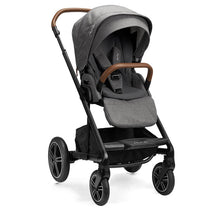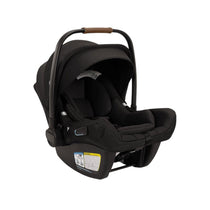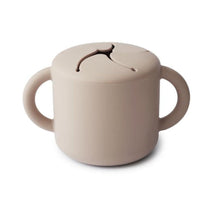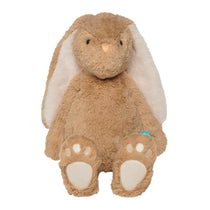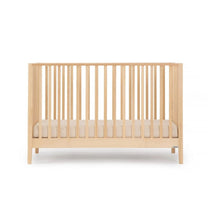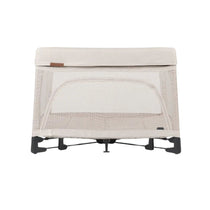Shop
-
Brand: Melo
Melo Comfort S Glider - Grey
The Melo Comfort S Glider is a luxurious and versatile seating solution designed for parents, caregivers, or anyone who enjoys the soothing effects of a glider. Ideal for feeding babies, calming toddlers, or simply relaxing, this glider offers comfort and style in one elegant...- $599.00
$0.00- $599.00
- Unit price
- per
-
Grey
-
Cream
-
Brand: Melo
Melo Comfort Glider - Cream
The Melo Comfort Glider is the perfect choice for parents seeking a soothing, stylish, and comfortable glider for any room in the house. Ideal for parents who need a calming space to feed the baby, calm toddlers, or simply relax after a long day,...- $549.00
$0.00- $549.00
- Unit price
- per
-
Cream
-
White
-
Grey
-
Brand: UPPAbaby
UPPAbaby Car Seat Adapters for Ridge, Maxi-Cosi, Nuna, Cybex and BeSafe
The Uppababy Car Seat Adapters for Ridge, Maxi-Cosi, Nuna, Cybex, and BeSafe are designed for parents who want to easily transform their Ridge stroller into a convenient travel system. This set of adapters allows you to securely attach select Maxi-Cosi, Nuna, Cybex, and BeSafe...- $54.99
- $54.99
- Unit price
- per
-
Brand: UPPAbaby
UPPAbaby Car Seat Adapters for Ridge, Mesa/ Mesa V2 and Mesa Max
The Uppababy Car Seat Adapters for Ridge, Mesa/Mesa V2, and Mesa Max are perfect solution for parents looking to create a seamless travel system with their Ridge stroller. Designed for parents with busy lifestyles, these adapters allow for the easy attachment of the Aria,...- $39.99
- $39.99
- Unit price
- per
-
Brand: UPPAbaby
UPPAbaby Travel Bag for RumbleSeat and Bassinet
The Uppababy Travel Bag for RumbleSeat and Bassinet is a must-have accessory for parents on the go, offering a stress-free solution for protecting your UPPAbaby gear during air travel. Designed for use with the UPPAbaby RumbleSeat and Bassinet, this travel bag ensures that your...- $89.99
- $89.99
- Unit price
- per
-
Brand: UPPAbaby
UPPAbaby Bevvy Stroller Cooler - Black/Gray
The UPPAbaby Bevvy Stroller Cooler is the perfect companion for parents who need to keep drinks and snacks cool while on the move. Designed for convenience and functionality, this insulated and leakproof cooler fits perfectly into your stroller basket, helping you manage day trips,...- $99.99
- $99.99
- Unit price
- per
-
Black/Gray
-
Brand: Peg Perego
Peg Perego Stroller Parent Organizer - Black -- Available End June
The Peg Perego Stroller Parent Organizer is a must-have accessory for parents using Peg Perego strollers. Designed for modern parents on the go, this compact yet spacious organizer solves the everyday challenge of keeping essentials within easy reach. Whether it's your baby’s snacks, bottles,...- $49.99
- $49.99
- Unit price
- per
-
Black -- Available End June
-
Brand: Slumberkins
Slumberkins Unicorn Kin, Authenticity
The Slumberkins Unicorn Kin with 2 Books is designed to empower children to embrace and celebrate their true selves. Targeting children aged 3 and up, this set helps young ones develop the confidence to express their emotions, uniqueness, and inner strength. Unicorn Kin is a...- $48.00
- $48.00
- Unit price
- per
-
Brand: Slumberkins
Slumberkins Sloth Kin, Routines
The Slumberkins Sloth Kin with 2 Books is the perfect companion for young children learning the value of structure and consistency. Targeting children from 3 years old and up, this set helps kids establish positive daily routines, promoting a sense of security and emotional well-being....- $48.00
- $48.00
- Unit price
- per
-
Brand: Slumberkins
Slumberkins Otter Kin, Building Connection
The Slumberkins Otter Kin with 2 Books is designed to help children understand the power of Building Connection and the importance of building meaningful relationships with their families and communities. Ideal for children aged 3 and up, this set introduces little ones to the...- $48.00
- $48.00
- Unit price
- per
-
Brand: Slumberkins
Slumberkins Lynx Kin, Self Expression
The Slumberkins Lynx Kin with 2 Books set is an empowering and educational resource for children, designed to help them understand and express their emotions with confidence. Ideal for children ages 3 and up, this set teaches kids the importance of self-expression and setting...- $48.00
- $48.00
- Unit price
- per
-
Brand: Slumberkins
Slumberkins Honey Bear Kin, Gratitude
The Slumberkins Honey Bear Kin with 2 Books is a thoughtfully crafted set designed to teach children the value of gratitude in an engaging and interactive way. Perfect for children ages 3 and up, this set helps kids cultivate a deep sense of thankfulness...- $48.00
- $48.00
- Unit price
- per
-
Brand: Slumberkins
Slumberkins Hammerhead Kin, Conflict Resolution
The Slumberkins Hammerhead Kin with 2 Books is a perfect resource to help children navigate the sometimes turbulent waters of conflict resolution and emotional regulation. Targeted for children ages 3 and up, this set provides kids with essential tools to understand and cope with...- $48.00
- $48.00
- Unit price
- per
-
Brand: Magnetic Me
Magnetic Me BAA BAA Baby Modal Footie, Blue - Newborn
The Magnetic Me BAA BAA Baby Blue Modal Magnetic Footie is the ultimate everyday essential for babies and new parents. Designed for quick and fuss-free changes, this footie features innovative SewSafe™ magnetic closures that make late-night diaper changes a breeze, quiet, smooth, and effortless....- $40.00
- $40.00
- Unit price
- per
-
Newborn
-
0 - 3 Months
-
3 - 6 Months
-
6 - 9 Months
-
Brand: Magnetic Me
Magnetic Me Delivered With Hare Modal Magnetic Footie - 0 - 3 Months
The Magnetic Me Delivered With Hare Modal Magnetic Footie is an essential, everyday piece for your baby’s wardrobe, designed to make dressing simple and comfortable. Perfect for newborns and toddlers, this footie features SewSafe™ magnetic closures, which make dressing and middle-of-the-night changes a breeze....- $40.00
- $40.00
- Unit price
- per
-
0 - 3 Months
-
3 - 6 Months
-
6 - 9 Months
-
9 - 12 Months
-
Brand: Magnetic Me
Magnetic Me BAA BAA Baby Modal Footie, Pink - Newborn
The Magnetic Me BAA BAA Baby Pink Modal Magnetic Footie is the ultimate everyday essential for babies and new parents. Designed for quick and fuss-free changes, this footie features innovative SewSafe™ magnetic closures that make late-night diaper changes a breeze, quiet, smooth, and effortless....- $40.00
- $40.00
- Unit price
- per
-
Newborn
-
0- 3 Months
-
3 - 6 Months
-
6 - 9 Months
-
Brand: Magnetic Me
Magnetic Me Charlotte Ruffle Modal Magnetic Footie - 0 - 3 Months
The Magnetic Me Charlotte Ruffle Modal Magnetic Footie is the ultimate blend of comfort, style, and convenience for both babies and parents. Perfect for newborns and toddlers, this footie features SewSafe™ magnetic closures, making dressing effortless, especially during middle-of-the-night diaper changes. The TENCEL™ modal...- $40.00
- $40.00
- Unit price
- per
-
0 - 3 Months
-
3 - 6 Months
-
6 - 9 Months
-
9 - 12 Months
-
Brand: Magnetic Me
Magnetic Me Emily Ruffle Modal Magnetic Footie - 0 - 3 Months
The Magnetic Me Emily Ruffle Modal Magnetic Footie is the perfect blend of comfort, style, and convenience for both babies and parents. Designed for newborns and toddlers, this footie features SewSafe™ magnetic closures that make dressing effortless, particularly during late-night diaper changes. The innovative...- $40.00
- $40.00
- Unit price
- per
-
0 - 3 Months
-
3 - 6 Months
-
6 - 9 Months
-
9 - 12 Months
-
Brand: Magnetic Me
Magnetic Me Rainbow Road Organic Cotton Magnetic Footie - 0 - 3 Months
The Magnetic Me Rainbow Road Organic Cotton Magnetic Footie is the ultimate in comfort and convenience for parents. Designed for babies up to 12 months, this footie simplifies dressing with its innovative SewSafe™ magnetic closures, making late-night diaper changes or morning get-ready sessions a...- $36.00
- $36.00
- Unit price
- per
-
0 - 3 Months
-
3 - 6 Months
-
6 - 9 Months
-
9 - 12 Months
-
Brand: Finn + Emma
Finn & Emma Short Sleeve Graphic Bodysuit, Chunky - 0-3 M
The Finn & Emma Short Sleeve Graphic Bodysuit is the perfect everyday essential for eco-conscious parents seeking comfort, safety, and style for their baby. Crafted from ultra-soft 100% organic cotton and dyed with non-toxic, eco-friendly colors, this bodysuit keeps baby cozy while offering peace...- $22.00
- $22.00
- Unit price
- per
-
0-3 M
-
3-6 M
-
6-9 M
-
9-12 M
-
Brand: Finn + Emma
Finn & Emma Short Sleeve Graphic Bodysuit, Place You Will Go - 0-3 M
The Finn & Emma Short Sleeve Graphic Bodysuit is the perfect everyday essential for eco-conscious parents seeking comfort, safety, and style for their baby. Crafted from ultra-soft 100% organic cotton and dyed with non-toxic, eco-friendly colors, this bodysuit keeps baby cozy while offering peace...- $22.00
- $22.00
- Unit price
- per
-
0-3 M
-
3-6 M
-
6-9 M
-
9-12 M
-
Brand: Finn + Emma
Finn & Emma Short Sleeve Graphic Bodysuit, Hangry - 0-3 M
The Finn & Emma Short Sleeve Graphic Bodysuit is the perfect everyday essential for eco-conscious parents seeking comfort, safety, and style for their baby. Crafted from ultra-soft 100% organic cotton and dyed with non-toxic, eco-friendly colors, this bodysuit keeps baby cozy while offering peace...- $22.00
- $22.00
- Unit price
- per
-
0-3 M
-
3-6 M
-
6-9 M
-
9-12 M
-
Brand: Finn + Emma
Finn & Emma Short Sleeve Graphic Bodysuit, Dad's Little Girl - 0-3 M
The Finn & Emma Short Sleeve Graphic Bodysuit is the perfect everyday essential for eco-conscious parents seeking comfort, safety, and style for their baby. Crafted from ultra-soft 100% organic cotton and dyed with non-toxic, eco-friendly colors, this bodysuit keeps baby cozy while offering peace...- $22.00
- $22.00
- Unit price
- per
-
0-3 M
-
3-6 M
-
6-9 M
-
9-12 M
-
Brand: Finn + Emma
Finn & Emma Short Sleeve Graphic Bodysuit, Pumpkin - 3-6 M
The Finn & Emma Short Sleeve Graphic Bodysuit is the perfect everyday essential for eco-conscious parents seeking comfort, safety, and style for their baby. Crafted from ultra-soft 100% organic cotton and dyed with non-toxic, eco-friendly colors, this bodysuit keeps baby cozy while offering peace...- $22.00
- $22.00
- Unit price
- per
-
0-3 M
-
3-6 M
-
6-9 M
-
9-12 M
-
Brand: Finn + Emma
Finn & Emma Short Sleeve Graphic T-Shirt, Big Sis - 12-24 Months
The Finn & Emma Short Sleeve Graphic T-Shirt is a must-have for every toddler’s wardrobe. Made from 100% organic cotton, this soft and stylish shirt offers the perfect balance of comfort, durability, and fun. Ideal for toddlers, this t-shirt features a delightful graphic that...- $22.00
- $22.00
- Unit price
- per
-
12-24 Months
-
2T
-
3T
-
4T
-
Brand: Finn + Emma
Finn & Emma Short Sleeve Graphic T-Shirt, Big Bro - 12-24 Months
The Finn & Emma Short Sleeve Graphic T-Shirt is a must-have for every toddler’s wardrobe. Made from 100% organic cotton, this soft and stylish shirt offers the perfect balance of comfort, durability, and fun. Ideal for toddlers, this t-shirt features a delightful graphic that...- $22.00
- $22.00
- Unit price
- per
-
12-24 Months
-
2T
-
3T
-
4T
-
Brand: Cybex
Cybex 5-in-1 EOS Travel System with Aton G Infant Car Seat - Black Frame with Moon Black
The Cybex EOS Travel System with Aton G Infant Car Seat combines the comfort of the EOS 2-in-1 stroller with the lightweight safety of the Aton G Infant Car Seat, providing a travel-ready solution that grows with your child. From newborn carriage mode to...- $599.95
- $599.95
- Unit price
- per
-
Black Frame with Moon Black
-
Black Frame with Lava Grey
-
Black Frame with Ocean Blue
-
Black Frame with Seashell Beige
-
Brand: Cybex
Cybex 5-in-1 EOS Travel System with Aton G Swivel with Sensorsafe - Moon Black With Black Frame
The Cybex 5-in-1 EOS Travel System with Aton G Swivel with SensorSafe is the perfect solution for modern families on the go. Designed for growing children, this innovative travel system transitions seamlessly from a newborn to a toddler and beyond, offering a comfortable and...- $699.95
- $699.95
- Unit price
- per
-
Moon Black With Black Frame
-
Moon Black With Silver Frame
-
Brand: Nuna
Nuna Lumn Harness Booster Car Seat - Cedar
The Nuna LUMN Harness Booster Car Seat is designed for growing children, providing them with both comfort and safety from little kid to big kid. Perfect for parents who want a versatile car seat that adapts to their child’s growth stages, the LUMN offers...- $700.00
- $700.00
- Unit price
- per
-
Cedar
-
Caviar
-
Granite
-
Brand: Silver Cross
Silver Cross Mealtime Set for Gourmet High Chair
The Silver Cross Mealtime Set for Gourmet High Chair is designed for babies beginning their weaning journey, offering a safe, stylish, and practical solution to early feeding. With ergonomically shaped components for little hands, the set makes self-feeding easier and mess-free. Made from food-safe silicone, the...- $69.99
- $69.99
- Unit price
- per











